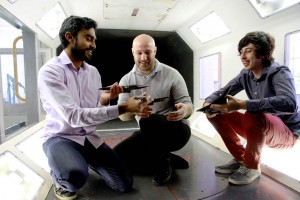The European Space Agency (ESA) has invited two University of Sydney aeronautical engineering PhD researchers to help realise the dream of travelling across the globe at 7 times the speed of sound.

David Munk and fellow researcher Jonathan Jeyaratnam have joined the HEXAFLY-INT project team – a A$33 million international collaboration focused on flying civil aircraft at hypersonic levels – to fulfil ESA’s ambition to fly from Brussels to Sydney in 2 hours.
Their research is being conducted as part of their Engineering PhD theses. David is working on designing algorithms that assist in novel structural designs for the aircraft that will support the high temperature of hypersonic flight.
“One of the main concerns is extreme heat. An aircraft experiences high thermal stresses and a significant reduction in material strength and stiffness when it is taking off or flying at supersonic speeds,” he said.
“To combat this reduction in strength and rigidity I am designing an optimal algorithm that will determine the best structural layout for such craft. My algorithm will add to the innovative structural concepts being created to handle the harsh environment experienced by the high-speed vehicles.”
His colleague, Jonathan, will build a low-speed model for testing at the University’s Marulan airstrip to assess how the aerodynamic design of hypersonic craft will handle the very different low-speed flows experienced at take-off and landing.
“The aerodynamics of a hypersonic plane is very different to a standard civil aircraft. I’m looking at the variation in the sizing, positioning and dihedral (upward) angle of the vertical tail to find out if their positioning can improve the lateral stability but not compromise performance of a craft that travels at Mach 7,” said Jonathan.
“I think perhaps an extension of the outboard portion of the wings at the tail may improve the stability of the vehicle at low speed and also improve performance.”
Dr Gareth Vio, who, together with Dr Dries Verstraete, is supervising David and Jonathan’s research and lectures in Aerospace Engineering at the School of Aerospace, Mechanical and Mechatronic Engineering, says hypersonic flight has been the holy grail of aeronautical research for more than six decades.
“David and Jonathan are coming up with radical new concepts for take-off trajectory and tail designs. The ESA was impressed by the Honors theses of both these students and invited them on-board the HEXAFLY-INT team based in Australia,” said Dr Vio.




















